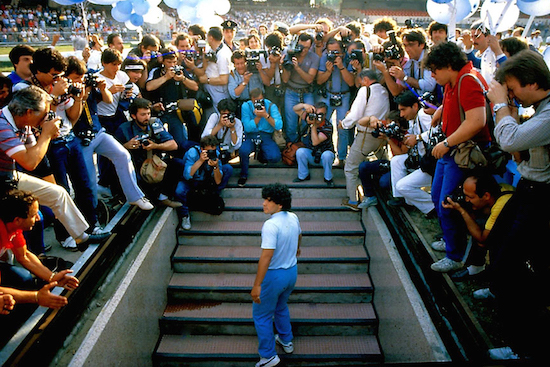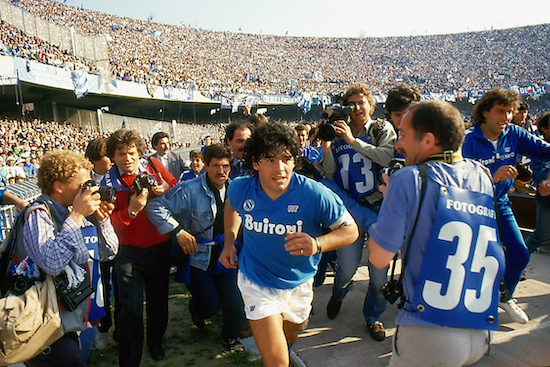Living in the shadow of a volcano must add a certain frisson to one’s existence. You get to enjoy the sweetest, most succulent tomatoes on earth on the one hand; on the other, you and the millions living on the ribbon of shoreline surrounding the angry scissure must live in the knowledge she could erupt anytime in the future, and with possibly devastating consequences. Mount Vesuvius looms over the city of Naples and offers a quotidian reminder of impermanence, while within its walls are figures of Saints who promise hope: Mary, Jesus, Diego Maradona…
The latter of course is not a prophet or beatific incarnation of the Lord, and he’s certainly not infallible. Maradona is a genuine icon to the people of Naples though, and not just in the overused modern connotation of the word. He’s almost as ubiquitous in the art that adorns the city walls as the aforementioned holy mother and child, often adjacent to icons, or even in the pictures themselves, swathed in divine arms. The religious devotion to one of the footballing greats is further proof if it were needed that Catholicism is only a monotheistic religion in theory. But then it’s easy to forget the scale of the miracles this boy from the slums of Villa Fiorito bestowed on the city back in the 1980s and early 90s. Asif Kapadia’s film does a fine job of reminding us.
Diego boasted a few years ago that he would have won more Ballon d’Ors than either Lionel Messi or Cristiano Ronaldo had he been eligible to receive it at the time (the rules were changed in 1995 to accommodate non-Europeans, but by then he was a spent force). Characteristically conceited though this claim is, he was certainly the best player on earth for a decade before his behaviour and subsequent drug addiction began to have consequences. Not that there weren’t problems before Napoli: Diego had arrived from Barcelona where he’d become a pariah within just two seasons because of his controversial conduct. The Catalan giants could afford to gamble the then record transfer fee of £5 million; the £6.9 million (also a record) that Napoli paid subsequently came with more risks for a club spending beyond its means in a southern Italian province where median wages were dwarfed by the supporters of the posh northern clubs. Maradona encountered racism and derogatory chanting from supercilious fans of clubs with more history – Juventus and Internazionale and so on; these merely became singing tormentors who would inspired him to make them suffer.
Napoli supporters meanwhile are famously fanatical about their team to the exclusion of everything else, and in spite of meagre pickings over the years. They live fast, hard and for the weekend. Maradona felt like he’d found his spiritual home, so it was a good match, for a while at least. The film is slightly disingenuous in suggesting the team were often threatened with relegation. Since returning to the top flight in 1965, the Partenopei hadn’t actually finished lower than 12th and sometimes finished 2nd or 3rd before Maradona’s arrival. Nevertheless the two Serie A titles and a UEFA Cup was astonishing and unprecedented, and that historic first league title (a league and cup double, no less) brought with it a similar far-fetched magic to that of Leicester City in the 2015-16 season in England. Concomitant to those glory years at his club, Maradona also propelled his country, Argentina, to win the World Cup in 1986, and helped guide them to the final of Italia ‘90, beating the hosts in the semis – the moment things began to come unstuck in Italy.
In 2017, Naples awarded Maradona the keys to the city, but 30 years before that the city became his jailer. Success brought intense scrutiny from the media, stifling levels of fame and adulation from fans, as well as a dangerous friendship with Neapolitan mafiosos, the Camorra, which brought with it unsavoury company and an unlimited supply of cocaine. Diego partied hard, fathered an illegitimate child and evaded the anti-doping regulators thanks to security lapses, and everyone was happy to turn a blind eye when the team was flying. His failings became blind spots as he performed miracles with his feet. It was only when Argentina beat Italy in the Stadio San Paolo that the scales began to fall from the eyes of the Italian fans and some of his own supporters.

In Kapadia’s film, Maradona’s appearance in the Campania region is more like divine intervention than a football signing, but his genius has a price, and the spectacular fall from grace is yet more dramatic and compelling. Like Senna and Amy, his previous documentaries in a similar vein, Diego Maradona relies on accumulated footage to tell the story without the prescriptive passages of a narrator, and again it provides a powerful punch while allowing viewers the space to draw their own conclusions. As for the storytelling, Kapadia has saved the best story for last. The idea to do a film about Maradona preceded even his lauded 2011 picture about Formula One legend Ayrton Senna: “[Diego] was in the ether in my brain as a character,” he told the Guardian in 2017. “In my mind, this is the third part of a trilogy of child geniuses and fame, and the effect it can have, and what they mean to their country and what they mean to people. Again, another person in various ways who felt like he was fighting a system.”
The director’s deep sense of empathy with his subjects is what makes them such essential viewing, and I’d argue that Diego Maradona is the most essential of all, given his impact and global fame. Certainly he inspires the most ambivalence, and the most polarised opinion, so it may come as a surprise to audiences indoctrinated by decades of tabloid propaganda that they warm to Maradona and come out of the film feeling at least a little of his pain. The conclusion is different to the others too of course, given that he’s still alive while Winehouse and Senna aren’t. In the hands of Kapadia he’s a corpulent spectre in a sad stasis, a kind of Jake LaMotta figure still struggling with the addiction that blighted an otherwise triumphant footballing epoch.
Kapadia’s real masterstroke is to confine the narrative to the Napoli years where everything is won and lost both on and off the field. The past and the future are alluded to, but everything the viewer really needs takes place within these seven years within the city. Diego Maradona ranks as one of the great sporting documentaries because it’s about so much more than sport (it’s a sports film for people who don’t like sport, or so the cliche goes, like When We Were Kings or Graham Taylor: An Impossible Job). Sportspeople are invariably uncompelling because having drive just isn’t enough to create dramatic spectacle exterior to the sport they participate in; chinks in the armour give us something relatable to cling to.
This then isn’t so much a film about sport as it is about class, addiction, celebrity, pressure and plenty of hubris, with some organised crime thrown in for good measure; a tale of genius and where it can take you, and disgrace and where that can take you too. Neapolitans may wince, or even weep, as they watch this film, beholding the monster they helped to shape. He’s a deity and a devil too, the best protagonists of all. The miraculous feats achieved with his feet are unlikely to be forgotten in Naples anytime soon, presuming there isn’t a molten lava-related act of God that sends them fleeing like the GOAT.
Diego Maradona directed by Asif Kapadia is released in UK cinemas on 14 June


